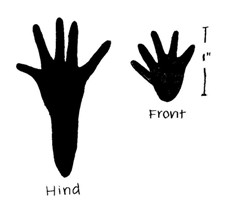 brown fur that is made up of both an outer layer which keeps them dry, and a heavy inside layer which helps them retain their body heat while swimming in the cold water that they inhabit. Their front feet are small and they have four fingers with claws and a small thumb which they use for grasping. The back feet are larger and have five webbed fingers with claws. Along with their webbed back feet and strong, flattened tail, the common muskrat is a very efficient swimmer. Their eyes and ears are very small and most times the ears are almost hidden in their thick fur. Their large incisor teeth are located in front of their cheek, allowing them to gnaw and chew submergent and aquatic vegetation while swimming underwater.
brown fur that is made up of both an outer layer which keeps them dry, and a heavy inside layer which helps them retain their body heat while swimming in the cold water that they inhabit. Their front feet are small and they have four fingers with claws and a small thumb which they use for grasping. The back feet are larger and have five webbed fingers with claws. Along with their webbed back feet and strong, flattened tail, the common muskrat is a very efficient swimmer. Their eyes and ears are very small and most times the ears are almost hidden in their thick fur. Their large incisor teeth are located in front of their cheek, allowing them to gnaw and chew submergent and aquatic vegetation while swimming underwater."The scientific name for the common muskrat, Ondatra zibethicus, comes from Indian and latin roots. The Indian name for the muskrat is Ondatra, and the Latin word zibethicus means musky in odor. A source of the name muskrat is believed to have come from the old English word musquash. This word was taken from the word móskwas, which was used by a group of Native Americans in North America hundreds of years ago."
Habitat and Geography:
Home Sweet Home
Muskrats can be found in a variety of habitats ranging from marshes, river, streams, lakes, Suitable habitats for muskrats must contain slow moving water, aquatic and submergent vegetation for eating and building lodges, and a water depth of about two to four feet. The
Muskrats build their own homes called lodges that look similar to beaver lodges. They are made
Usually two or muskrats will aid in building the lodge, such as a mating male and female, and they will start by finding a sturdy area to build on. This could be an old lodge or feeding platform, and it will serve as the base of their lodge. Once this base has been found, the muskrats will start to pile emergent plants that they can find and harvest near where they are building their lodge. They will do this until it is the size that they want. They then carve out a plunge hole which is used to enter and exit the lodge from underwater. Once that is finished, they build tunnels that can be used for several purposes. Some of these purposes
include space for breeding, winter burrows which is a small tunnel with a chamber attached to it, and burrows used for feeding. Finally, the muskrats carve out a hollow space in the middle of the domed part of the lodge which will serve as the nest chamber where they will be living all winter. The lodges they build for the winter have very thick walls to keep heat in while the temperatures are below freezing. Muskrats will also dig tunnels and chambers into the embankment of the body of water that they inhabit. During the winter muskrats will also make structures called push-ups. These are basically platforms that sit on top of the ice and are used to rest on and eat on during the winter. They are made by gnawing a hole through the ice and pushing vegetation out of the hole until it is about two feet in height and a desirable size for the muskrat that is building it.
********************************************************************************
I thought you might like to know a little bit about the muskrat. They are fascinating creatures...or maybe I've just been looking at those lodges for so long I can't get muskrats out of my head now. :)

